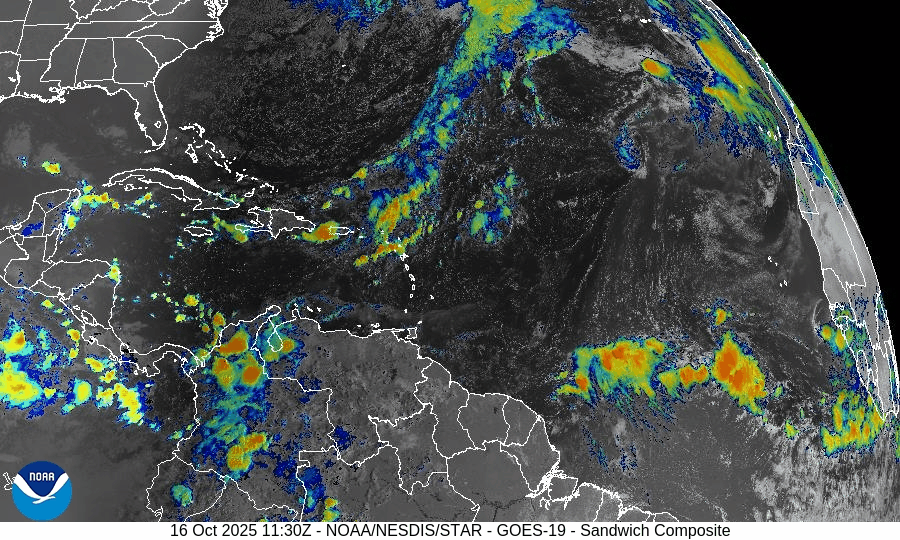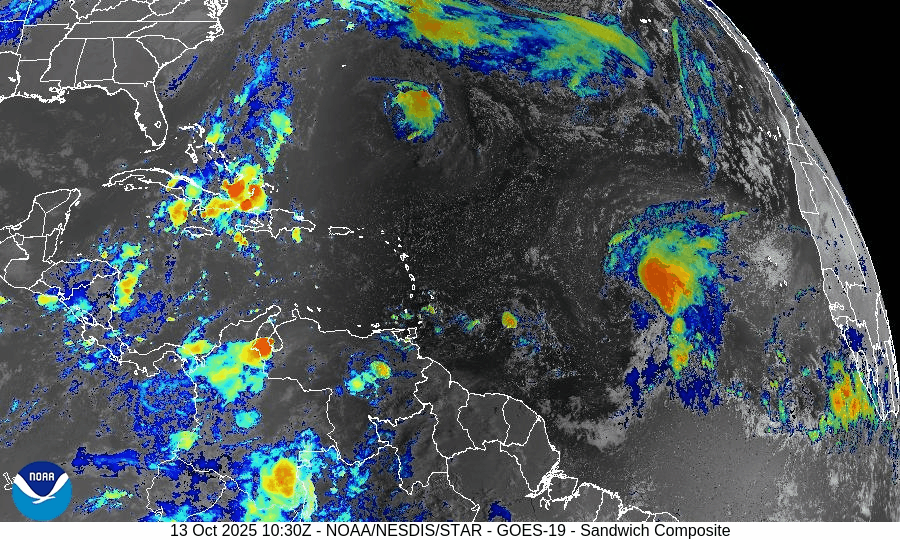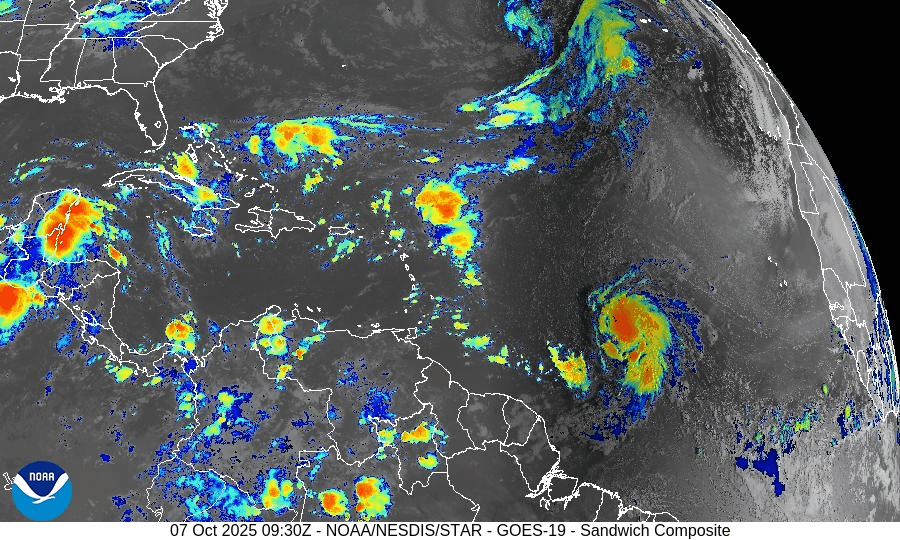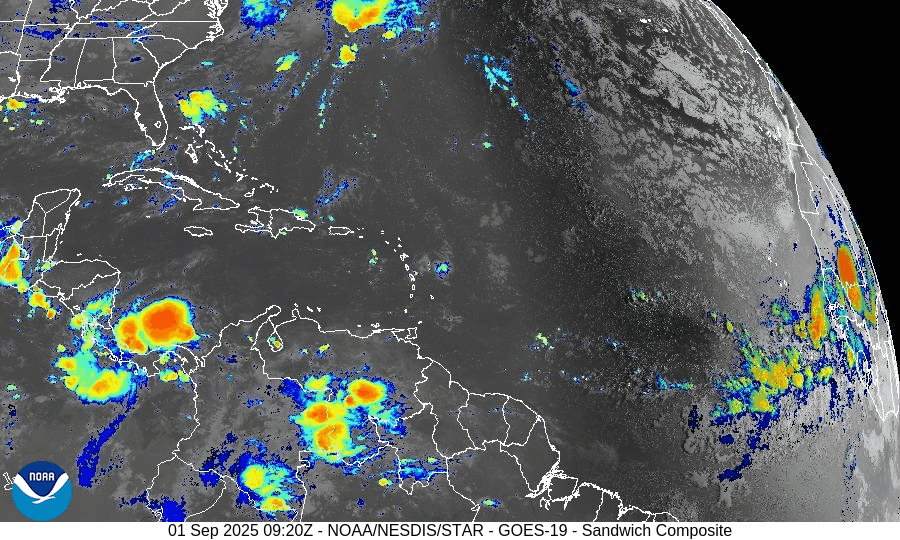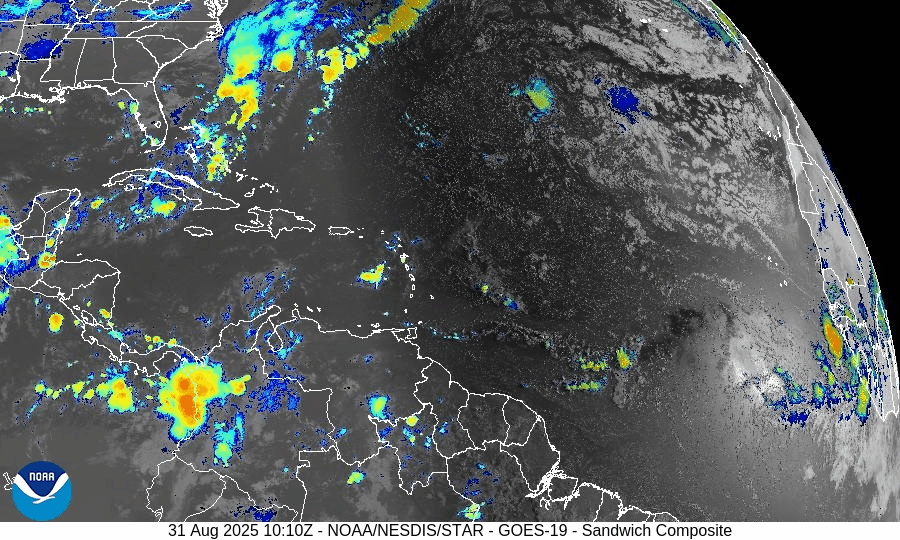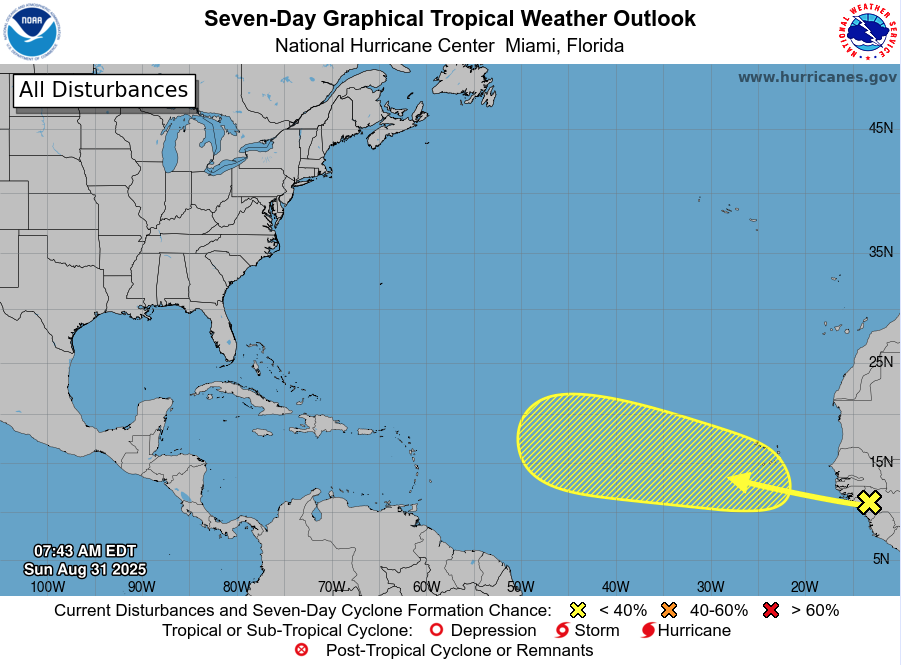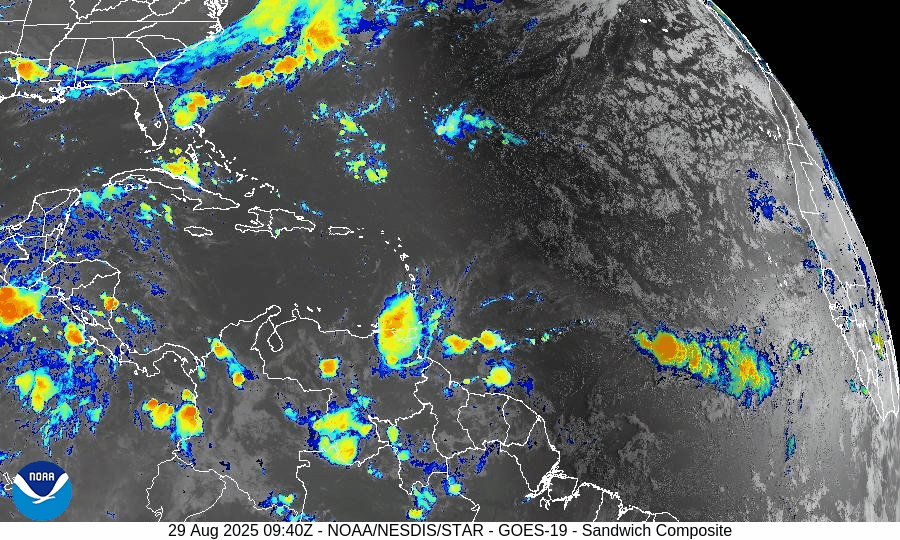Atlantic Hurricane Outlook – October 16, 2025
On October 16, Tropical Storm Lorenzo continues to weaken while tracking northeast over the central Atlantic with winds around 40 mph. Increasing wind shear, cooler waters, and dry air are causing the system to lose strength. No other tropical development is expected across the basin, and Florida and the Gulf of America remain quiet aside from minor marine swells and rip current risks.
Tropical Storm Lorenzo continues weakening over open waters; no new systems developing
Atlantic Basin Overview
Tropical Storm Lorenzo
Lorenzo is weakening while maintaining a general north to northeast track over the central Atlantic. Lorenzo has maximum sustained winds of about 40 mph, with tropical-storm-force winds extending outward roughly 60 miles from the center.
Lorenzo will shift toward the northeast later in the week and gradually dissipate, with no landfall expected.Other Tropical Activity
There are currently no other active tropical cyclones in the Atlantic, Caribbean, or Gulf basins. The NHC’s 7-day outlook indicates no additional tropical cyclone formation expected in that timeframe.
Environmental Conditions
Sea Surface Temperatures (SSTs):
Lorenzo is traversing moderately warm waters supportive of tropical structure, though as it moves northward it will encounter cooler SSTs that accelerate decay.Wind Shear:
The system continues to face moderate to strong vertical wind shear, which is limiting deep convection and contributing to its weakening trend.Dry Air / SAL (Saharan Air Layer):
Surrounding dry air and intrusions of dust remain factors, suppressing convection in outer bands and preventing reintensification.
Gulf of America & Caribbean
As of now, the Gulf of America and Caribbean remain quiet, with no organized tropical systems developing. Routine seasonal convection (showers, storms) continues.
Florida & Eastern U.S. Forecast
No tropical threats are forecast for Florida or the U.S. East Coast, as Lorenzo stays well offshore. The main impact to watch is marine hazards: lingering swells, rough surf, and rip currents along Atlantic beaches may continue through the period.
Rain forecast visualization courtesy of Windy.com
TL;DR – October 16 Snapshot
Lorenzo has weakened to ~40 mph and is heading northeast over open water.
No new tropical systems are being tracked.
Environmental conditions—shear, cooler SSTs, dry air—are eroding Lorenzo’s structure.
Gulf, Caribbean, Florida remain calm.
Coastal marine hazards remain the primary concern.
Atlantic Hurricane Outlook – October 13, 2025
On October 13, Tropical Storm Lorenzo formed in the central Atlantic with maximum winds near 45 mph and favorable conditions for further development. The system is expected to strengthen steadily as it moves west-northwest over warm 29–30°C waters. Meanwhile, post-tropical Jerry continues east of Bermuda, and Florida remains clear of tropical threats aside from elevated surf along the Atlantic coast.
Tropical Storm Lorenzo forms in the central Atlantic; Jerry now post-tropical east of Bermuda
Atlantic Basin Overview
Tropical Storm Lorenzo (formerly Invest 97L)
The National Hurricane Center has officially designated Tropical Storm Lorenzo (AL17) in the central tropical Atlantic, located near 12°N, 38°W, or roughly 900 miles southwest of the Cabo Verde Islands.
Lorenzo is moving west-northwest at around 15 mph, with maximum sustained winds near 45 mph and minimum central pressure near 1005 mb.Organization has improved significantly over the past 24 hours, with persistent convection consolidating around a developing center. The storm’s cloud structure shows banding features and outflow beginning to improve on its western flank.
Forecast & Track:
Lorenzo is expected to continue moving west-northwest for the next several days, gradually turning more northwest by midweek under the influence of a mid-level ridge.
Environmental conditions—warm sea surface temperatures (29–30°C), ample mid-level moisture, and low vertical wind shear (10–15 kt)—favor steady strengthening, and Lorenzo could become a hurricane by Wednesday or Thursday if current trends continue.Model guidance (ECMWF, GFS, and HWRF ensembles) indicates Lorenzo will likely remain over open waters through the week, though some long-range uncertainty remains regarding a possible westward bend late in the period.
Post-Tropical Jerry (east of Bermuda)
The remnants of Tropical Storm Jerry are now an elongated trough east-southeast of Bermuda. Gale-force winds (35–40 kt) persist along the northern edge, but the system lacks tropical characteristics and is not expected to redevelop. Seas near the trough remain 10–14 feet, gradually subsiding through Tuesday.Subtropical Storm Karen (north Atlantic)
Karen continues to weaken over the far North Atlantic, with maximum winds near 40 mph. The system is expected to lose its subtropical structure and dissipate within 24 hours over cold waters.
Environmental Conditions
Sea Surface Temperatures (SSTs):
SSTs across Lorenzo’s path remain well above average (29–30°C) — highly favorable for sustained deep convection and intensification.Wind Shear:
Current shear is low to moderate (10–15 kt) in the central Atlantic, allowing Lorenzo to organize further. Slight increases in shear may occur later this week as the storm tracks northwest.Humidity & Dry Air / SAL:
The Saharan Air Layer remains present north and east of Lorenzo but has receded sufficiently to the northeast. Moisture surrounding the storm’s core is increasing, limiting dry air intrusion and supporting vertical growth.
Gulf of America & Caribbean
The Gulf of America and Caribbean remain quiet. No tropical development is expected in these regions through at least the next 5–7 days. Afternoon convection and sea-breeze thunderstorms continue as typical for October.
Florida & Eastern U.S. Forecast
There are no immediate tropical threats to Florida or the U.S. East Coast. Lorenzo is far out in the central Atlantic, and current steering patterns favor a northwest track away from land.
Residual swell energy from past systems, combined with seasonal transitions, will continue to produce high surf and rip current risks along the Southeast and Mid-Atlantic beaches.
Otherwise, Florida remains under typical early-fall conditions—warm, humid afternoons with isolated sea-breeze storms.
Rain forecast visualization courtesy of Windy.com
TL;DR – October 13 Snapshot
Tropical Storm Lorenzo (AL17) has officially formed in the central Atlantic, moving WNW with 45 mph winds.
Favorable conditions (warm SSTs, low shear, and increasing moisture) support strengthening—could reach hurricane strength midweek.
Post-tropical Jerry continues east of Bermuda with lingering gales.
Karen dissipating in the North Atlantic.
No tropical threats to Florida or the U.S. mainland at this time.
Marine impacts (swells, rip currents) remain the primary concern along Atlantic beaches.
Atlantic Hurricane Outlook – October 7, 2025
On October 7, Invest 95L continues to consolidate in the central Atlantic, now with a 90% chance of development according to the National Hurricane Center. The disturbance is likely to become a tropical depression or named storm within 24–48 hours as it moves west-northwest through warm 29–30°C waters. No immediate land threats are expected, and Florida and the Gulf of America remain calm.
Invest 95L shows rapid organization; 90% chance of tropical development in the central Atlantic
Atlantic Basin Overview
Invest 95L (High Chance of Development)
The National Hurricane Center has increased development odds for Invest 95L to 90% over the next 7 days, as satellite imagery shows rapidly improving organization in the central tropical Atlantic, about halfway between the Cabo Verde Islands and the Lesser Antilles.The disturbance continues to consolidate with:
• Expanding convection around a developing low-level center.
• Stronger curvature in cloud bands.
• Favorable oceanic and atmospheric support for intensification.If current trends persist, this system will likely become a tropical depression within 24–48 hours, and could be named Tropical Storm Jerry soon after.
Model guidance continues to favor a west-northwest track through midweek, gradually turning more northwest by the weekend as it encounters subtropical steering.No immediate land threats are expected, though long-range trends will be monitored closely for potential shifts toward the western Atlantic later this week.
Other Atlantic Activity
No additional organized systems are currently being monitored.
Environmental Conditions
Sea Surface Temperatures (SSTs):
SSTs in the central Atlantic remain very warm (29–30 °C) — more than sufficient to support strengthening if the disturbance maintains convection.Wind Shear:
The system is positioned in a region of low to moderate vertical wind shear (10–15 kt), favorable for gradual intensification over the next few days. Shear may increase slightly later in the week as the system moves northwest.Humidity & Dry Air / SAL:
Moisture levels have improved, and the surrounding Saharan Air Layer (SAL) has thinned significantly, creating a more favorable pocket for development. Only minor dry air entrainment remains on the northern flank of the disturbance.
Gulf of America & Caribbean
The Gulf of America and Caribbean remain calm with no tropical development expected. Conditions are dominated by seasonal convection and scattered thunderstorms typical for early October.
Florida & Eastern U.S. Forecast
There are no immediate tropical threats to Florida or the U.S. East Coast.
The developing system is far east in the Atlantic, thousands of miles away. Even with potential intensification, model guidance currently suggests a turn away from the U.S. mainland later this week.
Coastal conditions: Residual swells and rip currents continue along Atlantic beaches from previous systems and may increase slightly if 95L strengthens further.
Rain forecast visualization courtesy of Windy.com
TL;DR – October 7 Snapshot
Invest 95L in the central Atlantic now carries a 90% chance of development.
Likely to become a tropical depression or named storm (Jerry) within 24–48 hours.
Favorable conditions: warm SSTs, light shear, improving humidity.
No immediate threat to Florida, the Caribbean, or the U.S. mainland.
Gulf of America remains quiet with no tropical formation expected.
Main hazards remain limited to marine impacts (rip currents, swell).
Atlantic Hurricane Outlook – September 1, 2025
On September 1, the Atlantic remains storm-free with no active cyclones. A tropical wave emerging off the coast of Africa carries a 40% chance of development over the next 7 days. While environmental conditions—wind shear, dry air, and Saharan dust—are suppressing rapid growth, the wave will be monitored closely. Florida and the Gulf of Mexico remain quiet, experiencing only typical early-September thunderstorms.
TLDR Version: Click Here
Atlantic remains quiet; tropical wave off Africa shows rising potential (40% over 7 days)
Atlantic Basin Overview
No Active Storms
There are currently no active tropical cyclones in the Atlantic basin—the first tranquil period we've seen since the wake of Fernand and Erin.Emerging Tropical Wave Off Africa
A new tropical wave has emerged off the West Coast of Africa near Guinea-Bissau. Presently disorganized, the NHC assigns it a 0% chance of development in the next 48 hours, but the probability rises to about 40% over the next 7 days. This system will be closely monitored as it moves west across the tropical Atlantic.
Environmental Conditions
Sea Surface Temperatures (SSTs): Remain warm in the Gulf and Caribbean (29–31 °C), while the open Atlantic heat content diminishes northward.
Wind Shear: Elevated shear across much of the basin continues to suppress storm formation.
Mid-Level Humidity & SAL (Saharan Air Layer): Dry air and SAL dust are widespread, inhibiting significant convection and limiting the strength of the new wave emerging off Africa.
Gulf of America & Caribbean
The Gulf remains stable and quiet, under the influence of high pressure. Only routine afternoon sea-breeze thunderstorms are expected—no tropical threats are present.
Florida & Southeast U.S. Forecast
Florida continues in its trademark late-August/early-September pattern: hot, humid, with scattered afternoon thunderstorms. With no active systems nearby, no coastal or tropical threats are expected this week.
Rain forecast visualization courtesy of Windy.com
Summary
No storms are currently active in the Atlantic basin.
A tropical wave off Africa is being monitored, with a 40% chance of developing within 7 days.
Environmental factors—including cool SSTs, strong shear, dry air, and SAL—are suppressing tropical development.
Gulf and Florida remain quiet, with only standard summertime weather patterns in play.
TL;DR – September 1 Snapshot
Atlantic is fully quiet; no active storms.
Tropical wave off Africa now has 40% 7-day development odds.
Hostile conditions in place, limiting immediate storm formation.
Florida and Gulf remain calm, aside from typical daily thunderstorms.
Atlantic Hurricane Outlook – August 31, 2025
On August 31, the Atlantic remains storm-free following the dissipation of Fernand and Erin’s exit. The only feature of interest is a tropical wave moving off Africa, with a low 30% development chance over the next 7 days. Environmental conditions—wind shear, dry air, and Saharan dust—continue to limit storm formation. Florida and the Gulf remain calm aside from typical summer storms.
TLDR Version: Click Here
Atlantic basin remains quiet; a weak wave off Africa shows low (30%) development odds
Atlantic Basin Overview
No Active Storms
There are currently no active tropical cyclones in the Atlantic basin. The calm continues following Fernand’s dissipation and the end of Erin’s impacts.Tropical Wave Near Africa
A tropical wave is forecast to emerge off the west coast of Africa, and the NHC assigns it a low – but not negligible – chance of development: 0% over the next 2 days, increasing to 30% over the next 3 to 7 days.
Environmental Conditions
Sea Surface Temperatures (SSTs): Warm in the Caribbean and Gulf (~29–31 °C), but less favorable conditions in much of the open Atlantic.
Wind Shear: Continues to be elevated across large swaths of the basin, discouraging storm formation.
Mid-Level Humidity & SAL: Dry air and Saharan dust (SAL) remain prevalent, further suppressing convective activity.
Gulf of Mexico & Caribbean
The Gulf remains quiet and stable, dominated by high pressure. Only routine afternoon thunderstorms are occurring along the coasts—no tropical development is expected.
Florida & Southeast U.S. Forecast
Florida continues in its late-August pattern—hot, humid, with scattered afternoon thunderstorms. No tropical threats are present.
Beaches along the Atlantic coast are beginning to calm. With no new swells incoming, rip currents and surf conditions are generally improving, though caution remains prudent in areas still unsettled from earlier systems.
Rain forecast visualization courtesy of Windy.com
Summary
Atlantic basin is currently calm, with no tropical storms or hurricanes active.
A new tropical wave off Africa carries low (30%) development odds over the next week.
Environmental factors (cooler SSTs, shear, dry air, and SAL) continue to limit development potential.
Gulf and Florida remain storm-free, apart from the usual summer thunderstorms.
TL;DR – August 31 Snapshot
The Atlantic is quiet and free of active storms.
A wave off Africa has low (30%) chance of development by next week.
Environmental conditions remain unfavorable for new formations.
Florida and Gulf remain calm with only routine seasonal storms.
Atlantic Hurricane Outlook – August 29, 2025
On August 29, Fernand dissipated in the far North Atlantic, marking the first quiet period in weeks across the basin. No tropical systems are active, though a weak wave off Africa shows low development potential. The Gulf of Mexico and Florida remain calm, experiencing only routine summer thunderstorms.
TLDR Version: Click Here
Fernand has dissipated; no active tropical storms, but a new wave off Africa warrants monitoring
Atlantic Basin Overview
Fernand Has Dissipated
Post-tropical Fernand has fully dissipated over the far North Atlantic. As of the last advisory on August 28, 0900 UTC, it was centered near 41.2°N, 42.9°W, moving east-northeast at ~23 mph with maximum winds of 35 knots (40 mph) and a minimum pressure of 1009 mb. No further advisories will be issued, and the system is no longer a threat to land.
No Active Tropical Systems
Currently, there are no active tropical storms or hurricanes in the Atlantic basin. Model tracking tools confirm the basin is completely clear of active systems.
New Disturbance Emerging Near Africa
The NHC is observing a tropical wave east of the Cabo Verde Islands. This wave features no significant convection and is currently under the influence of Saharan dust. While its development odds are low in the short term, there’s a 20% chance of development over the next 7 days.
Environmental Conditions
Sea Surface Temperatures (SSTs): Warm waters (~29–31 °C) persist in the Gulf and Caribbean, but cooling temperatures across the open Atlantic now that Fernand is gone.
Wind Shear: Elevated wind shear continues to suppress development across most of the Atlantic.
Mid-Level Relative Humidity & Saharan Air Layer (SAL): Dry air and SAL dust are prevalent—particularly near the new wave off Africa—further hampering development.
Gulf of America (Mexico) & Caribbean
The Gulf remains quiet and stable, with high pressure dominating. Only typical afternoon thunderstorms are expected; no organized or tropical development is forecast.
Florida & Southeast U.S. Forecast
Florida continues to experience standard late-summer weather—hot, humid, with scattered afternoon thunderstorms. The absence of major tropical features means no new coastal threats.
Atlantic beaches are finally beginning to calm after prolonged rough surf from previous systems, though caution remains advised where noticeable wave action persists.
Rain forecast visualization courtesy of Windy.com
Summary
Fernand has dissipated; no tropical cyclones remain in the Atlantic.
Atlantic remains quiet, with only a small wave emerging near Africa carrying limited development potential.
Environmental factors—cooler SSTs, wind shear, dry air, and SAL—continue to suppress tropical activity.
Gulf and Florida show no signs of tropical development, carrying on with typical summer weather patterns.
TL;DR – August 29 Snapshot
Fernand is no longer active and poses no threat.
Atlantic basin is quiet—only a minor wave off Africa is being watched.
Environmental conditions remain unfavorable for storm formation.
Florida and Gulf continue with routine stormy weather; beaches are calming.

